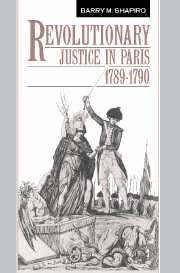Book contents
- Frontmatter
- Contents
- Preface
- Acknowledgments
- List of abbreviations
- Introduction
- 1 Revolutionary justice in 1789–1790: the Comité des Recherches, the Châtelet, and the Fayettist coalition
- 2 The judicial aftermath of the July Revolution
- 3 The Besenval affair: amnesty or prosecution?
- 4 Lafayette, Orléans, and the October Days
- 5 The post-October Days campaign against the left
- 6 The Favras conspiracy
- 7 The Favras–Besenval judicial transaction
- 8 The Maillebois conspiracy
- 9 The October Days affair and the radicalization of the Comité des Recherches
- 10 The Maillebois and October Days affairs: mutual amnesty and the breakup of the Fayettist coalition
- Conclusion
- Notes
- Select bibliography
- Index
4 - Lafayette, Orléans, and the October Days
Published online by Cambridge University Press: 16 October 2009
- Frontmatter
- Contents
- Preface
- Acknowledgments
- List of abbreviations
- Introduction
- 1 Revolutionary justice in 1789–1790: the Comité des Recherches, the Châtelet, and the Fayettist coalition
- 2 The judicial aftermath of the July Revolution
- 3 The Besenval affair: amnesty or prosecution?
- 4 Lafayette, Orléans, and the October Days
- 5 The post-October Days campaign against the left
- 6 The Favras conspiracy
- 7 The Favras–Besenval judicial transaction
- 8 The Maillebois conspiracy
- 9 The October Days affair and the radicalization of the Comité des Recherches
- 10 The Maillebois and October Days affairs: mutual amnesty and the breakup of the Fayettist coalition
- Conclusion
- Notes
- Select bibliography
- Index
Summary
In authorizing the arrest and trial of Besenval, the National Assembly had, however reluctantly, set into motion a procedure which has been repeated countless times in countless revolutions in the past two centuries, the prosecution of a representative of a defeated regime by a group of victorious revolutionaries. However, the judicial aftermath of the October Days followed an entirely different pattern. For, in direct contrast to the defeated military commander Besenval, the principal target of the revolutionary regime's investigation of the October Insurrection was one of the leading heroes of the seemingly victorious insurgents.
When the people of Paris marched to Versailles on October 5, 1789 to fetch “the baker, the baker's wife, and the little baker boy,” Louis-Philippe-Joseph Duc d'Orléans (1744–94) was being hailed by many of the marchers as “notre père” and even as “roi.” And when the marchers returned the next day, in an “indescribable procession” which included a captured king and the severed heads of two of his bodyguards, this “Red Prince” was still the object of great acclaim. Yet, within ten days, Orléans would be informally exiled from France, and, soon afterwards, legally pursued as the principal suspect in a Châtelet probe into the “crimes of October,” a probe which formed part of a general post-October Days judicial campaign against the revolutionary left.
- Type
- Chapter
- Information
- Revolutionary Justice in Paris, 1789–1790 , pp. 84 - 98Publisher: Cambridge University PressPrint publication year: 1993

